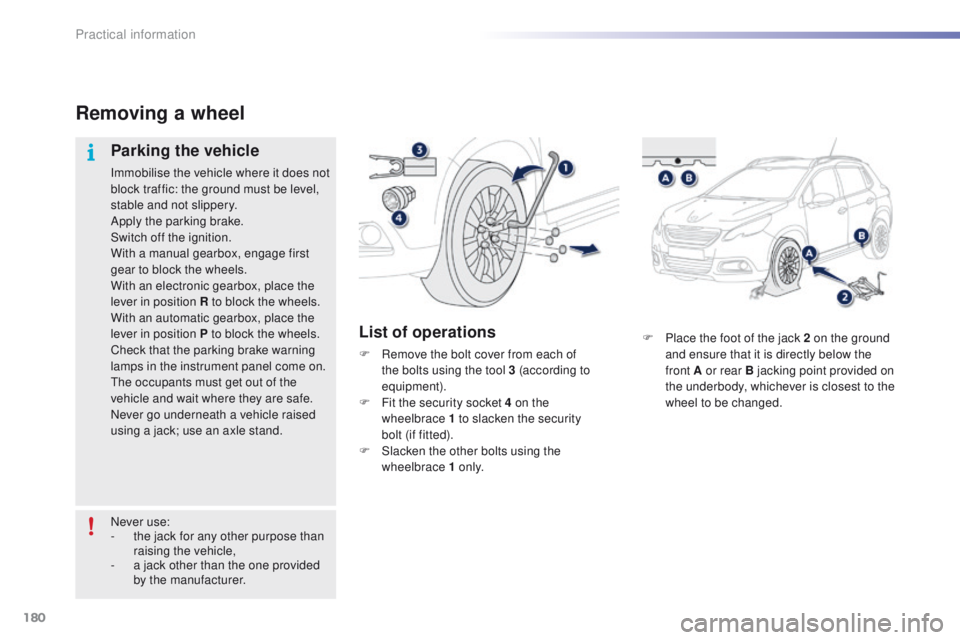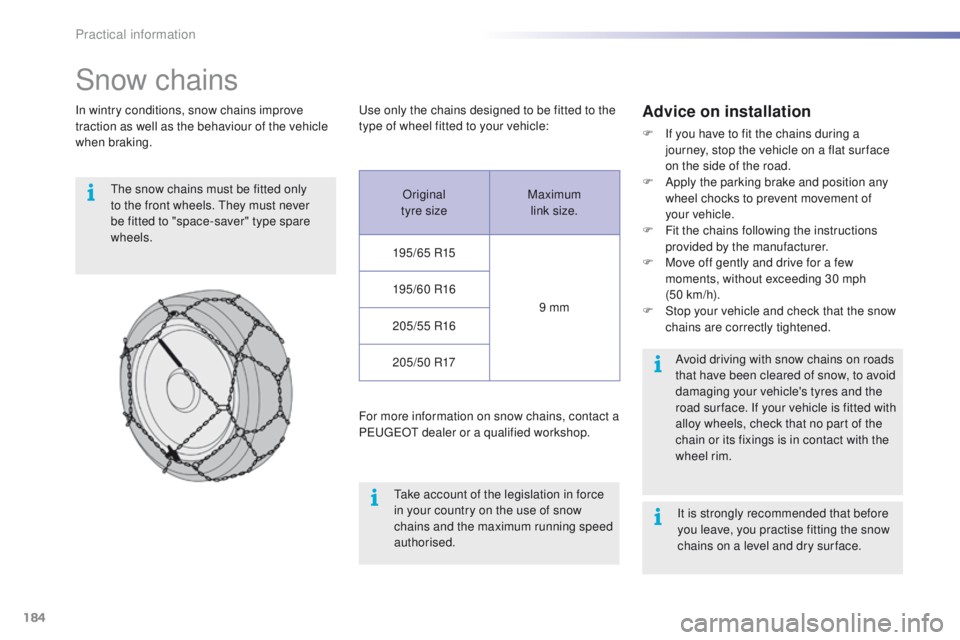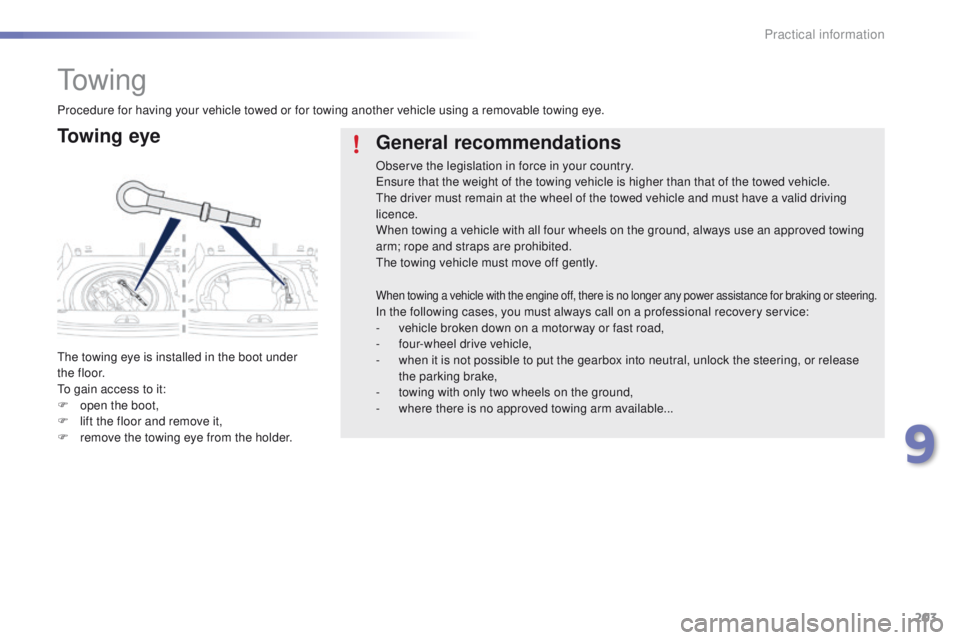2015 PEUGEOT 2008 parking brake
[x] Cancel search: parking brakePage 109 of 340

107
2008_en_Chap05_conduite_ed01-2015
Park Assist
This system provides active assistance with parking, detecting a parking space then controlling the steering to park in the space.
It controls the steering while the driver manages the accelerator, brakes, gears and clutch (manual gearbox). During phases of entry into and exit from
a parking space, the system provides visual and audible information to the driver in order to make the manoeuvre safe. It may be necessary to move
forwards and backwards more than once.The Park Assist system cannot in any
circumstances replace the care and
responsibility of the driver.
The driver must remain in control of
their vehicle ensuring that the space
remains clear during the manoeuvre.
In some circumstances, the sensors
may not detect small obstacles located
in their blind spots.
Changing tyre sizes (out-size tyres,
winter tyres, ...) can inter fere with
the correct operation of the parking
assistance system.
During a manoeuvre the steering wheel
turns quickly: do not hold the steering
wheel, do not place your hand between
the spokes of the steering wheel and
take care with loose and bulky clothing,
scarves, handbags... There is a risk of
injury. For entry into a parking space (parallel
parking) the system does not detect
spaces which are clearly much smaller
or larger than the size of the vehicle.
This "parking assistance" system
is activated automatically during
manoeuvres; it is therefore possible
that a symbol comes on in the screen,
accompanied by an audible signal,
without affecting the manoeuvre.
The system provides assistance in entering and
exiting a parking space when parallel parking. The driver can take control at any time by
gripping the steering wheel.
The selection of the type of manoeuvre
(entering or exiting a parallel parking
space) prevents a change to STOP
mode of Stop & Start.
In STOP mode, this selection restarts
the engine.
5
Driving
Page 182 of 340

180
2008_en_Chap09_info-pratiques_ed01-2015
F Place the foot of the jack 2 on the ground and ensure that it is directly below the
front
A or rear B jacking point provided on
the underbody, whichever is closest to the
wheel to be changed.
Removing a wheel
Parking the vehicle
Immobilise the vehicle where it does not
block traffic: the ground must be level,
stable and not slippery.
Apply the parking brake.
Switch off the ignition.
With a manual gearbox, engage first
gear to block the wheels.
With an electronic gearbox, place the
lever in position R to block the wheels.
With an automatic gearbox, place the
lever in position P to block the wheels.
Check that the parking brake warning
lamps in the instrument panel come on.
The occupants must get out of the
vehicle and wait where they are safe.
Never go underneath a vehicle raised
using a jack; use an axle stand.
List of operations
F Remove the bolt cover from each of the bolts using the tool 3 (according to
equipment).
F
F
it the security socket 4 on the
wheelbrace
1 to slacken the security
bolt (if fitted).
F
S
lacken the other bolts using the
wheelbrace 1 o n l y.
Never use:
-
t
he jack for any other purpose than
raising the vehicle,
-
a j
ack other than the one provided
by the manufacturer.
Practical information
Page 186 of 340

184
2008_en_Chap09_info-pratiques_ed01-2015
Snow chains
In wintry conditions, snow chains improve
traction as well as the behaviour of the vehicle
when braking.The snow chains must be fitted only
to the front wheels. They must never
be fitted to "space-saver" type spare
wheels.
Take account of the legislation in force
in your country on the use of snow
chains and the maximum running speed
authorised.
Use only the chains designed to be fitted to the
type of wheel fitted to your vehicle:
For more information on snow chains, contact a
PEUGEOT dealer or a qualified workshop.Advice on installation
F If you have to fit the chains during a
journey, stop the vehicle on a flat sur face
on the side of the road.
F
A
pply the parking brake and position any
wheel chocks to prevent movement of
your
vehicle.
F
F
it the chains following the instructions
provided by the manufacturer.
F
M
ove off gently and drive for a few
moments, without exceeding 30 mph
(50 km/h).
F
S
top your vehicle and check that the snow
chains are correctly tightened.
Avoid driving with snow chains on roads
that have been cleared of snow, to avoid
damaging your vehicle's tyres and the
road sur face. If your vehicle is fitted with
alloy wheels, check that no part of the
chain or its fixings is in contact with the
wheel rim.
Original
tyre size Maximum
link size.
195/65 R15
9 mm
195/60 R16
205/55 R16 205/50 R17
It is strongly recommended that before
you leave, you practise fitting the snow
chains on a level and dry sur face.
Practical information
Page 205 of 340

203
2008_en_Chap09_info-pratiques_ed01-2015
To w i n g
To w i n g e y e
The towing eye is installed in the boot under
t h e f l o o r.
To gain access to it:
F
o
pen the boot,
F
l
ift the floor and remove it,
F
r
emove the towing eye from the holder.
General recommendations
Observe the legislation in force in your country.
Ensure that the weight of the towing vehicle is higher than that of the towed vehicle.
The driver must remain at the wheel of the towed vehicle and must have a valid driving
licence.
When towing a vehicle with all four wheels on the ground, always use an approved towing
arm; rope and straps are prohibited.
The towing vehicle must move off gently.
When towing a vehicle with the engine off, there is no longer any power assistance for braking or steering.In the following cases, you must always call on a professional recovery service:
- v ehicle broken down on a motor way or fast road,
-
f
our-wheel drive vehicle,
-
w
hen it is not possible to put the gearbox into neutral, unlock the steering, or release
the parking brake,
-
t
owing with only two wheels on the ground,
-
w
here there is no approved towing arm available...
Procedure for having your vehicle towed or for towing another vehicle using a removable towing eye.
9
Practical information
Page 206 of 340

204
2008_en_Chap09_info-pratiques_ed01-2015
Towing your vehicleTowing another
vehicle
F On the front bumper, unclip the cover by
inserting the flat end of the towing eye in
the bottom of the cover.
F
S
crew the towing eye in fully.
F
I
nstall the towing arm. F
O n the rear bumper, unclip the cover by
pressing at the bottom.
F
S
crew the towing eye in fully.
F
I
nstall the towing arm.
F
S
witch on the hazard warning lamps on
both vehicles.
F
M
ove off gently, drive slowly and for a short
distance.
F
P
lace the gear lever in neutral
(position N on an electronic or
automatic gearbox).
F
ailure to observe this instruction
could result in damage to
certain components (braking,
transmission...) and the absence
of braking assistance the next time
the engine is started.
F U nlock the steering by turning the key
in the ignition one notch and release the
parking brake.
F
S
witch on the hazard warning lamps on
both vehicles.
F
M
ove off gently, drive slowly and for a short
distance.
Practical information
Page 208 of 340

206
2008_en_Chap09_info-pratiques_ed01-2015
Driving advice
Distribution of loads
F Distribute the load in the trailer so that the heaviest items are as close as possible to
the axle and the nose weight approaches
the maximum permitted without
exceeding
it.
Air density decreases with altitude, thus
reducing engine performance. Above
1
000 metres, the maximum towed load must
be reduced by 10
% for every 1 000 metres of
altitude.
Side wind
F Take into account the increased sensitivity to side wind.
Cooling
Towing a trailer on a slope increases the
temperature of the coolant.
As the fan is electrically controlled, its cooling
capacity is not dependent on the engine speed.
F
T
o lower the engine speed, reduce your
speed.
The maximum towed load on a long incline
depends on the gradient and the ambient
temperature.
In all cases, keep a check on the coolant
temperature.
F
I
f the warning lamp and
the
STOP warning lamp come
on, stop the vehicle and switch
off the engine as soon as
possible.
Braking
Towing a trailer increases the braking distance.
To avoid overheating of the brakes on a long
mountain type of descent, the use of engine
braking is recommended.
Ty r e s
F Check the tyre pressures of the towing vehicle and of the trailer, observing the
recommended pressures.
Lighting
F Check the electrical lighting and signalling on the trailer.
The rear parking sensors will be
deactivated automatically if a genuine
PEUGEOT towbar is used.
Refer to the "Technical data" section for details
of the weights and towed loads which apply to
your vehicle.
Practical information
Page 220 of 340

218
2008_en_Chap10_verifications_ed01-2015
Manual gearbox
The gearbox does not require any
maintenance (no oil change).
Refer to the warranty and
maintenance record for the checking
interval for this component.
Electronic gearbox
The gearbox does not require any
maintenance (no oil change).
Refer to the warranty and
maintenance record for details of the
checking interval for this component.
Automatic
gearbox
The gearbox does not require any
maintenance (no oil change).
Refer to the warranty and
maintenance record for details of
the level checking interval for this
component.Brake wear depends on the style
of driving, particularly in the case
of vehicles used in town, over short
distances. It may be necessary to have
the condition of the brakes checked,
even between vehicle services.
Brake pads
For information on checking brake
disc wear, contact a PEUGEOT
dealer or a qualified workshop.
Brake disc
wear
Parking brake
If excessive travel or a loss of
effectiveness of this system is
noticed, the parking brake must be
checked, even between two services.
Only use products recommended by
PEUGEOT or products of equivalent
quality and specification.
In order to optimise the operation of
units as important as those in the
braking system, PEUGEOT selects and
offers very specific products.
After washing the vehicle, dampness,
or in wintry conditions, ice can form
on the brake discs and pads: braking
efficiency may be reduced. Make light
brake applications to dry and defrost
the brakes.
Checking this system must be done by a
PEUGEOT dealer or a qualified workshop.
Unless there is a leak in the circuit, a drop in
the brake fluid level indicates that the brake
pads are worn.
Checks
Page 334 of 340

332
2008_en_Chap13_index-alpha_ed01-2015
Seats, front ......................................................55
Seats, heated .................................................. 56
Seats, rear
....................................................... 57
Selector lever, electronic gearbox system
.............................. 83, 86, 218
Serial number, vehicle
.................................. 23
0
Service indicator
............................................. 28
Servicing
...............................
..........................12
Settings (Menus)
........................................... 268
Settings, system
............................................ 276
Sidelamps
...................... 111, 115, 116, 187, 189
Side repeater
..............................
..................188
Snow chains
.................................................. 18
4
Socket, 12 V accessory
..................................71
S
ocket, auxiliary
............................................ 264
Socket, JACK
..........................................72, 264
Sockets, audio
........................................ 72, 322
Sockets, auxiliary
.......................................... 322
Speed limiter
........................................... 99, 103
Starting the engine
......................................... 79
Starting the vehicle
............................83, 86, 90
Starting using another battery
......................................................... 19
9
Station, radio
......................................... 26
0, 261
Stay, bonnet
.................................................. 2 11
Steering mounted controls, audio
........................................................... 238
Steering wheel, adjustment
.................................................... 58
S
topping the vehicle
..........................83, 86, 90
Stop & Start
................................ 39, 69, 95, 107,
159, 198, 211, 217
Storage
...................................................... 70, 71
Stowing rings
.................................................. 74
Switching off the engine
..................................................... 79
Synchronising the remote control
........................................................... 45
R
emote control ....................................
4
2, 43, 46
Removing a wheel
........................................ 180
Removing the mat
........................................... 73
Replacing bulbs
............................ 185, 189, 19 0
Replacing fuses
..............................
.............. 192
Replacing the air filter
................................... 217
Replacing the oil filter
................................... 2
17
Replacing the passenger compartment filter
...................................... 217
Replacing wiper blades .................................123
Resetting the service indicator
....................... 30
Resetting the trip recorder
.............................. 40
Reversing lamp
..................................... 18
9, 191
Risk areas (update)
....................................... 2 51
Roof bars
....................................................... 2
07
Routine checks
..................................... 217, 218
Running out of fuel (Diesel)
.......................... 16
3
Radio
.................................... 260, 261, 264, 300
Radio, digital (Digital Audio Broadcasting - DAB)
........................... 262, 263
RDS
............................................................... 261
Rear foglamp ................................................. 113
Rear screen, demisting
................................... 69
Recharging the battery
................................. 20
0
Recirculation, air
............................................. 66
Reduction of electrical load
.......................... 201
Regeneration of the particle emissions filter
............................................ 217
Reinitialising the remote control
..................... 45
R
Park Assist .................................................... 10 7
Parking brake .......................................... 81, 218
Parking lamps
............................................... 11 6
Parking sensors, front
...................................10 6
Parking sensors, rear .................................... 105
Particle emission filter
..........................216, 217
Passenger compartment filter
......................217
PEUGEOT Connect Apps
.............................279
P
E
UGEOT
C
onnect Assistance
...................233
P
E
UGEOT
C
onnect Packs
...........................233
P
E
UGEOT
C
onnect SOS
............................. 2
32
Player, Apple
® .............................. .................266
Player, MP3 CD ............................. 264, 302-304
Player, USB
................................................... 264
Port, USB
....................................... 7
2, 264, 303
Pressures, tyres
............................................ 176
Priming the fuel system
................................ 163
Protecting children
................ 141, 145, 146, 151, 154-157
Puncture
........................................................ 172
Safety, children
............................................. 15
6
Safety for children
.........................................15 8
Screen, instrument panel
..........................3 7, 3 8
Screen menu
........................240, 242, 246, 254,
256, 258, 268, 280, 282
Screen menu map
.......240, 242, 246, 254, 256,
258, 268, 280, 282, 311, 325
Screenwash
..................................................120
Screenwash fluid level
..................................215
Screenwash, rear
..........................................121
Screen-wash reservoir
.................................215
SCR (Selective Catalytic Reduction)
.................................................. 16
4
SCR system
..................................................16 4
Seat belts
....................................... 1
3 8 -14 0, 15 0
S
Alphabetical index